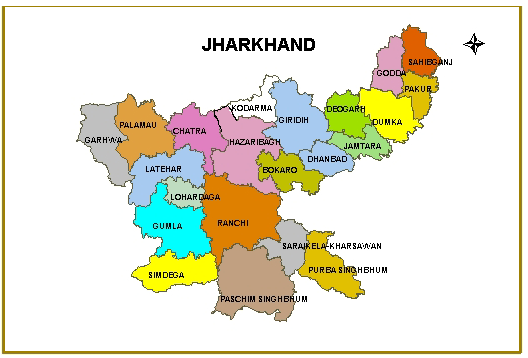Bihar Anjuman believes in self-help rather than charity
Related Materials
PEACE TV
SHAREISLAM TV
ISLAM CHANNEL
HUDA TV
TARAWEEH TV
Bible: Shave off a woman's head if it's not covered
Dr. Zakir Naik on Sania Mirza's dress
Dr. Farhat Hashmi on Hijab (audio mp3)
Can't win GOLD medal in Asian Games wearing Hijab? Watch out!
What is Hijab and why it's mandatory, as per Quran?
The Hidden Pearls (and the veiled women)
Hijab is not a piece of cloth on your head
Bikini and G-String Are OK But Wearing Hijab or Veil is Bad!!
Why Hijab? Women speak
Video: How to wear Hijab?
Ummah Films: That's not Hijab!
Why Hijab? Explains Bilal Philips
Why Hijab? Dr. Zakir Naik explains along with others
A Profile of Jharkhand [all info from official website of Jharkhand Govt]

|
Jharkhand GIS Map|| Districts || Tourism || Key
Contacts
The 28th state of the Indian Union was brought into existence by the Bihar reorganization Act on November 15,2000- the birth anniversary of the legendary Bhagwan Birsa Munda. Jharkhand is famous for its rich mineral resources like Uranium, Mica, Bauxite, Granite, Gold, Silver, Graphite, Magnetite, Dolomite, Fireclay, Quartz, Fieldspar, Coal (32% of India), Iron, Copper (25%of India) etc. Forests and woodlands occupy more than 29% of the state which is amongst the highest in India. |
|
| FACT SHEET (as per 2001 Census) about Jharkhand | |
| Population | 2,69,09,428 |
| Male Population | 1,38,61,277 |
| Female Population | 1,30,48,151 |
| Per Capita Income | Rs. 4161.00 |
| Density of Population | 338 persons / Sq. KM |
| No. of Districts | 24 |
| No. of Sub divisions | 35 |
| No. of Blocks | 212 |
| No. of Villages | 32620 |
| No. of Villages Electrified | 14667 (45 % of total) |
| No. of Villages connected by Road | 8484 |
| National Highways | 1006 KMs |
| State Highways | 4662 KMs |
| Health Centers | 506 |
| Schools | 21386 |
| Universities | 5 Incl. One Deemed University |
| Total Geographical Area | 79.70 Lakh Hect |
| Cultivable Land | 38.00 Lakh Hect |
| Net Sown Area | 18.04 Lakh Hect (25% of total area) |
| Net Irrigated Area | 01.57 Lakh Hect (8% of net shown area) |
| Forest | 29% of total area |
|
The
region enshrouded in the hills and forests inaccessible to a large
segment of people. The tribes of this state are living here from
thousands of years and not much changed in their life and culture over
the ages baring last few decades. Many scholars now believe that the
language used by tribes in the state of Jharkhand is identical to the
one used by Harappan people. This has led to a great interest in the
deciphering of Harappan inscriptions using rock paintings and language
used by these tribes.
|
| For
a greater part of Vedic age, Jharkhand remained obscured. During the
age of Mahajanpadas around 500 BC, India saw the emergence of 16 large
states who controlled the entire Indian subcontinent. The supremacy of
the janpads were often decided by the power of swords and bows and ax
and other weapons. The region around Jharkhand was extremely rich in
its mineral resources including iron and the janpad that controlled
this region, Magadha, eventually controlled most of the country. The
power of Magadha continued to occupy central state in Indian
subcontinent for a long time and saw the emergence of mighty empires
such as Mauryas and Guptas. After the end of last big Hindu empire of
Guptas, India saw emergence of a number of numerous regional powers who
tried to control this region. Same was the case with Muslim Sultans of
Delhi and their feudatories in Bengal, who tried to control this
mineral-rich area. British identified this region as a great source of
raw material for their booming industries back home and to exploit the
region to its full potential, established a vast network of railway
line. Calcutta was developed as a major port to export raw materials
from this region to England. |
| Birsa
Munda (1875-1900)and Sidho and Kanho are the legendary heroes of the
tribals of this state who fought against the oppressive rule of the
British government. Birsa Munda, now regarded as god, fought for the
tribals natural right over forests and land that was mercilessly being
acquired by the British for exploitation. After a long fight, Birsa
Munda was captured by the British authorities and died in prison. Sidho
and Kanho were another set of revolutionaries among the tribals, now
regarded as a tribal heroes. |
| For a long time, Jharkhand remained as a part of Bihar, but after Indian independence, the demand for a separate state of tribals started gaining momentum. In the last fifty years, the tribes of this region fought against the hegemony of Northern Bihar, a region that gained from the mineral deposits of this region like anything. Jharkhand became a state under the Republic of India on November 15, 2000 and now it is poised for a great leap forward. |

